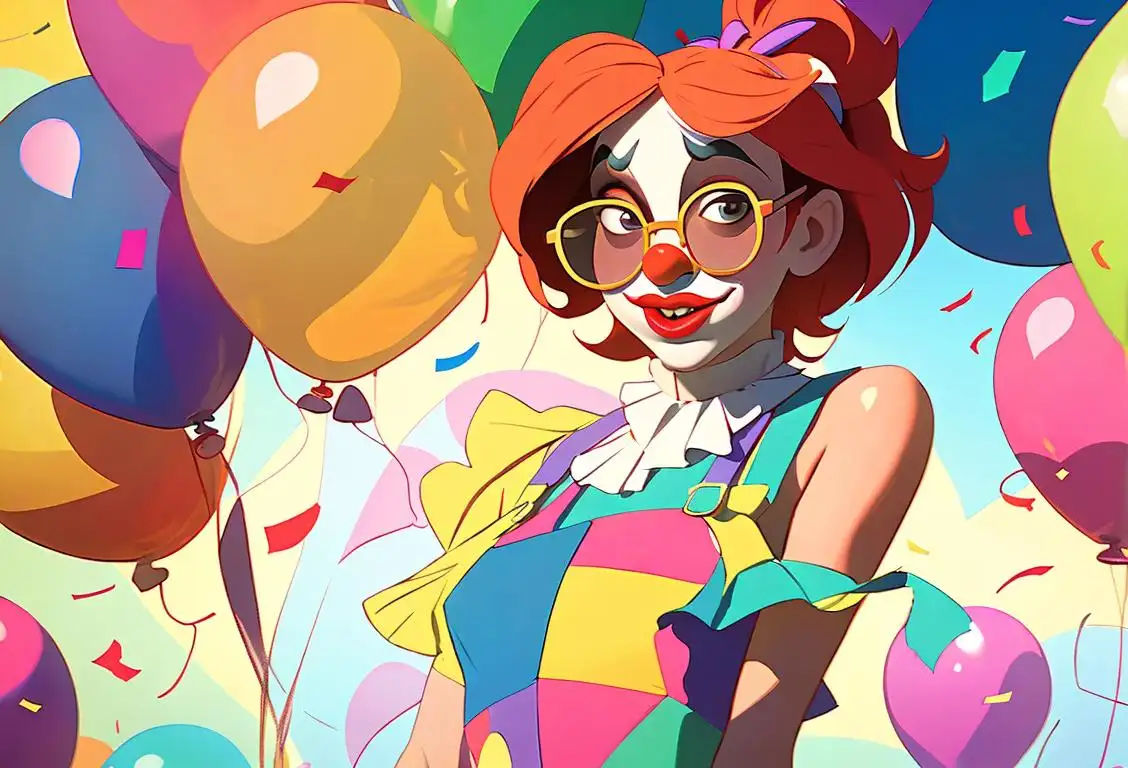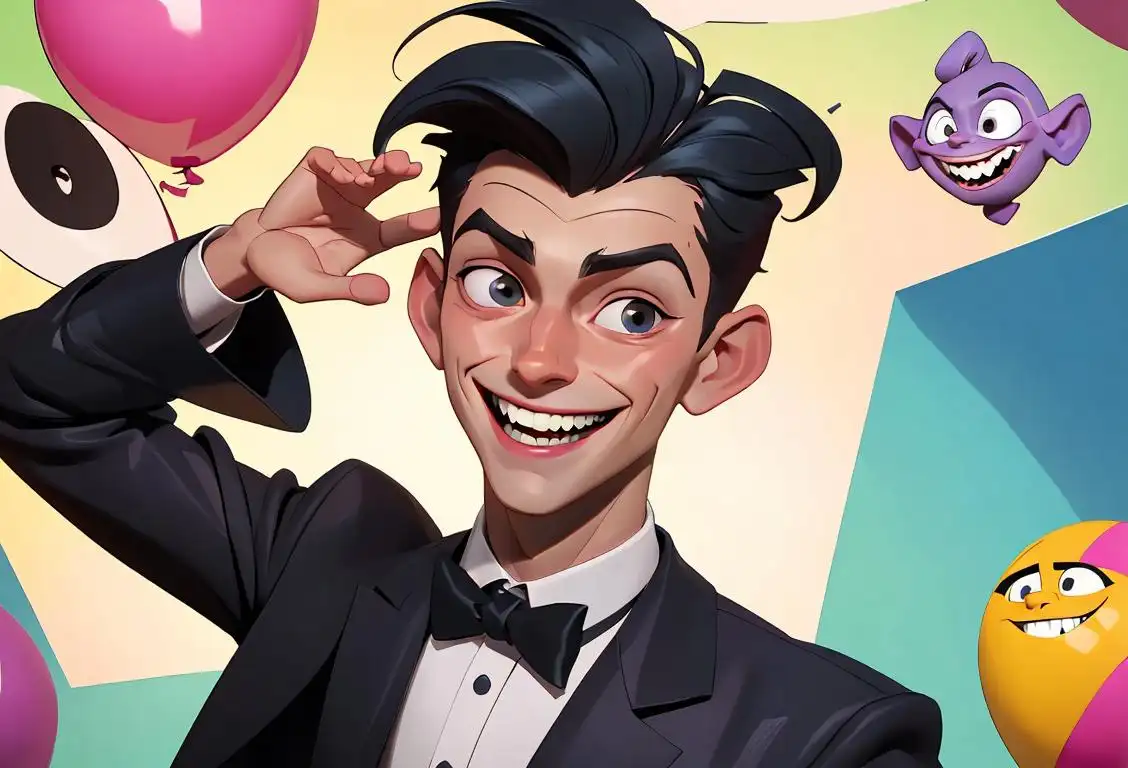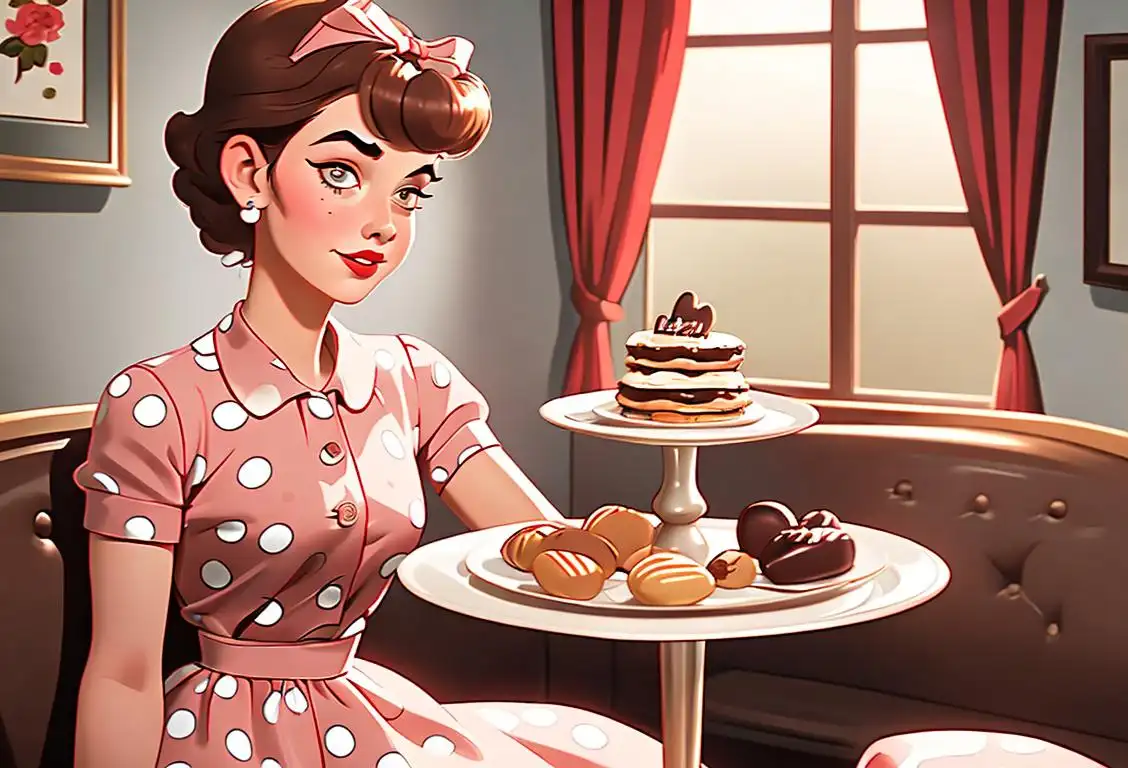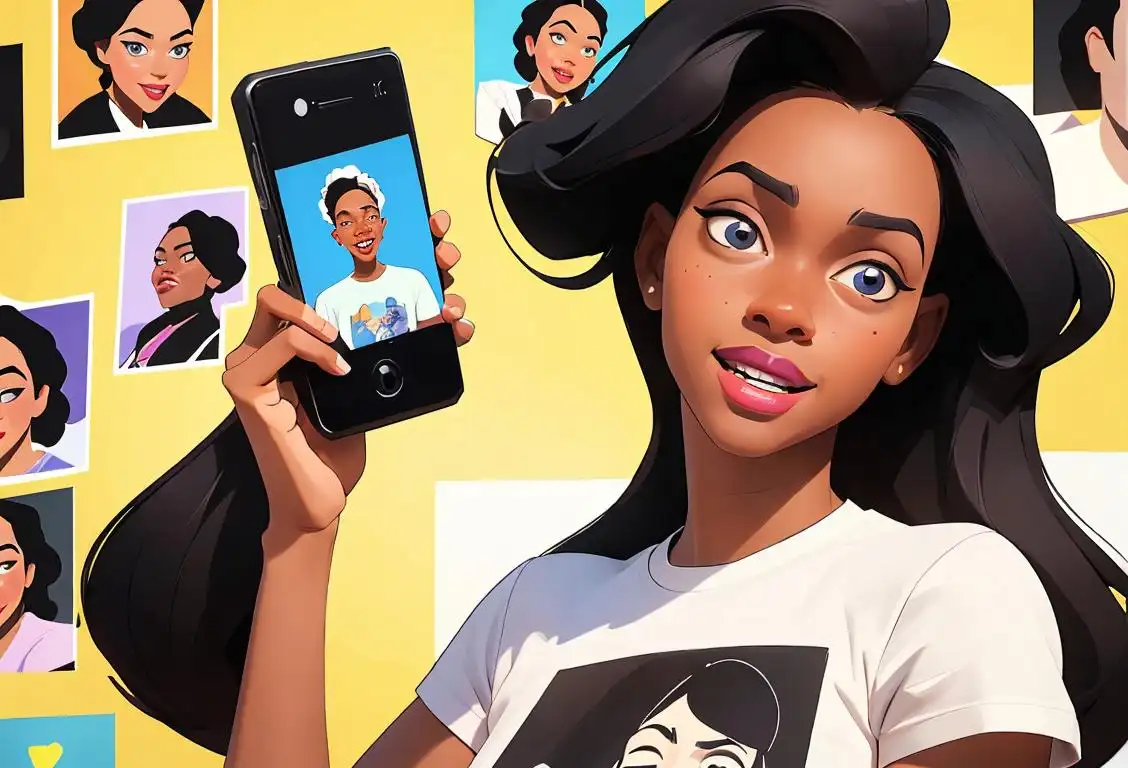National Improv Day

Welcome to the wacky world of National Improv Day! Get ready to laugh, think on your feet, and embrace the unexpected. Whether you're a seasoned improv performer or just love a good dose of spontaneous humor, this national day is your time to shine. So, grab a funny hat, gather your funny friends, and let's dive into the fascinating history of National Improv Day!
When is Improv Day?
It's national improv day on the 1st April.
The Birth of Laughter: The Origins of National Improv Day
On April 1, 2017, the internet exploded with mentions of National Improv Day. It's no surprise that this day dedicated to the art of improvisation falls on April Fools' Day, a day known for its playful pranks and light-hearted tomfoolery. The origins of National Improv Day can be traced back to comedy clubs and theaters where talented performers have been using their wit and quick thinking to tickle our funny bones for ages.
Improvisational comedy, or improv, is all about spontaneous creativity. It's a form of theater where performers create scenes, stories, and characters on the spot without a script. Think of it as the ultimate test of comedic timing and imagination. Improv forces performers to trust their instincts and work together as a team to create something hilarious and unique.
Improvisation has a rich history that dates back to ancient times. The ancient Greeks used improvisation in their comedies, and even Shakespeare had his fair share of improvised moments on stage. But it wasn't until the 20th century that improv truly took center stage. It became a staple of comedy clubs, with famous groups like The Second City and The Groundlings paving the way for future improv enthusiasts.
National Improv Day celebrates the magic of improv comedy and honors those brave performers who can make us belly laugh without a safety net. It's a day to appreciate the spontaneous brilliance of improv and the incredible talent of those who make it happen. Whether you've ever stepped foot in an improv class or not, National Improv Day is for you. So, put a smile on your face and get ready to embrace the unexpected laughter!
History behind the term 'Improv'
16th Century
The Commedia dell'arte Tradition
Improv has its roots in the Commedia dell'arte tradition of the 16th century. Commedia dell'arte was a form of professional theater that originated in Italy. It featured masked actors who performed in improvised scenarios based on stock characters and basic plot outlines. The performers would often add their own witty dialogue and physical comedy to entertain the audience.
1918
The birth of improvisational theater
The term 'improv' originated from the world of theater. In 1918, Viola Spolin, an American theater practitioner, introduced the concept of improvisational theater as a training method for actors. She believed that improvisation helped actors improve their spontaneity, creativity, and connection with their fellow performers. Spolin's teachings laid the groundwork for what would later become known as 'improv' in popular culture.
1924
Origin of the term 'improv'
The term 'improv', short for improvisation, was coined by Viola Spolin in 1924. Spolin was an American theater educator and the founder of the famous improvisational theater group called The Second City in Chicago. She developed a series of techniques and games that allowed actors to create scenes spontaneously without a script. Spolin believed that by tapping into their own imagination and instinct, actors could deliver truly authentic performances.
1920
Rise of Improvisational Theater
The term 'improv' originated in the 1920s with the rise of improvisational theater. This theatrical form focused on spontaneous and unscripted performances, allowing actors to create scenes, dialogue, and characters on the spot. Improv brought a fresh and innovative approach to stage performances, deviating from the traditional scripted plays.
late 16th century
Origins in Commedia dell'Arte
The term 'improv' has its origins in Commedia dell'Arte, a form of theatrical entertainment that originated in Italy in the late 16th century. Commedia dell'Arte was characterized by its use of stock characters, exaggerated physicality, and the virtuosity of the actors' improvisation. Performers would often engage in witty and spontaneous dialogue, creating comedic scenes on the spot. This tradition of improvisation would later influence the development of improvisational theater.
1509
Shakespeare's Influence
During the Elizabethan era, the famous playwright William Shakespeare popularized the art of improvisation by incorporating it into his plays. Shakespeare's actors would often engage in impromptu dialogue and actions during performances, adding an element of spontaneity and creativity. This marked the early development of what would later be known as improv.
1959
Rise of improv comedy
In 1959, a group of comedians known as The Compass Players, inspired by Viola Spolin's teachings, formed the first improvisational comedy group in the United States. The Compass Players eventually evolved into The Second City, which became the breeding ground for many talented comedians including John Belushi, Bill Murray, and Tina Fey. Improv comedy gained popularity as performers delighted audiences with their quick wit, hilarious scenes, and comedic timing, all created on the spot.
1924
Viola Spolin's son takes the torch
Viola Spolin's son, Paul Sills, continued to develop and popularize the art of improvisation. In 1955, Sills founded The Compass Players, a Chicago-based improvisational theater group, which later evolved into The Second City. The Second City became a breeding ground for talented improvisational actors and comedians, contributing significantly to the rise of 'improv' in the entertainment industry.
16th-18th Century
Improvisation in Elizabethan England
During the Elizabethan era in England, improv became popular within the realm of theater. In performances known as 'ad hoc' or 'extemporal' plays, actors were given a basic plot and improvised their dialogue based on their own wit and creativity. This form of improvisation allowed actors to showcase their comedic talents and engage the audience with unexpected and spontaneous performances.
1950s
Improvisational theater movement
In the 1950s, a movement known as improvisational theater gained popularity in the United States. Inspired by Commedia dell'Arte and influenced by the rise of experimental theater, this movement sought to break away from traditional scripted performances and embrace spontaneity and creativity. Improvisational theater groups, such as The Second City in Chicago and The Compass Players in New York City, began to thrive, introducing new forms and techniques to the art of improvisation.
1940
Viola Spolin and The Second City
In the 1940s, Viola Spolin, known as the 'mother of improvisation,' introduced improvisational theater techniques as a teaching method. She developed various theater games and exercises to improve actors' spontaneity and creativity. Spolin's work was further popularized by The Second City, a renowned improvisation theater company founded in Chicago in 1959. The Second City helped legitimize improv as an art form.
1762
Commedia dell'arte
In the 18th century, the Italian theatrical tradition of Commedia dell'arte emerged. Commedia dell'arte was characterized by its use of stock characters and improvised performances. Actors would rely on their wit and quick thinking to deliver comedic sketches and dialogues. This form of improvisation laid the groundwork for future improv techniques.
1960
Improvisational Comedy on TV
The 1960s brought the introduction of improvisational comedy to television. Shows like 'The Jonathan Winters Show' and 'Whose Line Is It Anyway?' showcased the improvisational prowess of performers, bringing the art form to a broader audience. Improv comedy quickly gained popularity as a comedic genre known for its quick wit, humor, and unexpectedness.
1960s
Keith Johnstone and Theatresports
In the 1960s, British-Canadian theater director Keith Johnstone introduced a competitive improvisational format called 'Theatresports.' Drawing inspiration from sports and game theory, Theatresports added an element of competition to improvisational performances. The format involved teams of actors competing against each other, responding to audience suggestions and performing scenes in real-time. Theatresports became widely popular and spread to various countries, influencing the development of improvisational comedy as a form of entertainment.
1967
'Improvisation' becomes an official term
In 1967, the term 'improvisation' officially entered the theatrical lexicon. The International Theater Institute, a worldwide organization dedicated to the promotion of performing arts, recognized improvisation as a distinct and legitimate form of theatrical expression. This acknowledgment helped solidify the term and its significance in the world of theater and performance.
1975
Long-form improv emerges
Long-form improvisation, also known as Harold, was developed by theater director Del Close and improviser Charna Halpern in 1975. This format allowed an entire show to be created from a single audience suggestion, giving performers the freedom to explore different characters, storylines, and themes over an extended period. Long-form improv became especially popular in the 1990s with groups like ImprovOlympic (now called iO) and the Upright Citizens Brigade, leading to the widespread adoption of this format in improv theaters across the world.
19th-20th Century
Improvisation as a Theatrical Movement
In the late 19th and early 20th centuries, improv began to evolve as a distinct theatrical movement. Influential figures such as Konstantin Stanislavski and Viola Spolin emphasized the importance of improvisation in actor training. Stanislavski, a Russian theater practitioner, believed that improvisation helped actors develop a deeper understanding of their characters and the emotional truth of a scene. Spolin, an American theater educator, developed improvisational exercises to unleash creativity and vulnerability in performers.
1930s
Theatrical Improvisation Groups
In the 1930s, various theatrical improvisation groups started to form. These groups, such as the Compass Players and The Second City, focused on creating improvised scenes and sketches. The comedic and theatrical elements of improv were further developed, and improv started to gain recognition as a distinct art form.
1970
Keith Johnstone and Theatresports
In 1977, Keith Johnstone, a theater teacher and improviser, created Theatresports, a competitive improvisational format. Theatresports incorporated elements of sports and games into improvisation, pitting teams of improvisers against each other in a comedic battle. The format gained international recognition and sparked the growth of improvisation as a competitive art form.
2006
Improv in mainstream media
In 2006, the television show 'Whose Line Is It Anyway?' brought improv comedy into the homes of millions of viewers around the world. The show featured a group of talented improvisers who performed a series of comedic games and scenes based on audience suggestions. With its witty humor and unpredictable performances, 'Whose Line Is It Anyway?' introduced a new generation to the joy and creativity of improv. The success of the show paved the way for other comedy programs and films that showcased the art of improvisation.
1970s
Improv expands to television
During the 1970s, improvisation made its way onto television screens. Shows like 'Whose Line Is It Anyway?' and 'Saturday Night Live' popularized 'improv' as a form of comedic entertainment. These programs showcased talented improvisers who amazed audiences with their quick wit and ability to create spontaneous, humorous scenes on the spot. The medium of television helped bring 'improv' into the mainstream and reach a wider audience.
1955
The Birth of 'Improvisation'
The term 'improvisation' gained popularity in 1955 with the publication of Viola Spolin's book 'Improvisation for the Theater.' Spolin, often considered the mother of modern improvisational theater, introduced innovative techniques that emphasized teamwork, spontaneity, and the principle of 'Yes, And' – where performers build upon each other's ideas.
1970s
Improvisational comedy on television
The 1970s saw the rise of improvisational comedy on television. Shows like 'Whose Line Is It Anyway?' showcased the talents of improvisational comedians, who performed hilarious scenes, games, and skits based on audience suggestions. These televised performances brought improvisational comedy to a wider audience, popularizing the art form and fostering a renewed interest in improv as a source of entertainment.
1950s
Improvisation in Comedy
During the 1950s, improv became closely associated with comedy. In Chicago, a group of performers called The Compass Players popularized a style of comedic improv known as 'improvisational theater' or 'improv comedy.' This form of improv involved creating scenes, sketches, and comedic situations on the spot, often inspired by audience suggestions. The Compass Players later evolved into The Second City, a renowned comedy theater and training center that has had a significant influence on modern improv comedy.
1990s
Improv goes global
In the 1990s, 'improv' began to gain international recognition and popularity. Improvisational theater companies emerged worldwide, catering to diverse cultures and audiences. Festivals dedicated to improv sprouted up in different countries, creating opportunities for improvisers to showcase their skills and learn from one another. The global expansion of 'improv' highlighted its universal appeal and demonstrated its ability to transcend language and cultural barriers.
Present day
Continued popularity and applications
Today, improv has grown beyond the realm of theater and comedy. It has found applications in various fields, including business, education, and personal development. Improv training is now utilized to enhance communication skills, foster creativity, and promote teamwork in corporate settings. Additionally, improvisational techniques are utilized in educational settings to help students develop critical thinking, collaboration, and adaptability. The cultural impact of improv continues to evolve, with its influence extending far beyond the stage.
1975
Improvisational Comedy on Television
The television show 'Whose Line Is It Anyway?' premiered in 1975, bringing improvisational comedy to a wider audience. The format of the show featured comedians performing improvised skits, scenes, and games based on prompts from the host or the audience. 'Whose Line Is It Anyway?' became a global phenomenon and further popularized improv as a form of entertainment.
1990
Long-form Improv
During the 1990s, long-form improv gained prominence. Long-form improv involves creating extended narratives and character arcs through improvisation. Groups like the Upright Citizens Brigade (UCB) popularized this format, emphasizing collaboration and ensemble work. Long-form improv allowed improvisers to delve deeper into characters and storylines, adding depth and complexity to their performances.
1980s-Present
Improvisation in Popular Culture
Since the 1980s, improvisation has become a pervasive element in popular culture. Improv comedy groups like the Upright Citizens Brigade and Whose Line Is It Anyway? gained widespread popularity, leading to the integration of improv into television shows and movies. Improv techniques have also been adapted into various forms of entertainment, including video games, podcasts, and storytelling events. Today, improv continues to thrive as a dynamic and spontaneous art form that promotes creativity, teamwork, and quick thinking.
Present
Improv transcends the stage
Today, improv has extended far beyond the realm of theater and comedy. It has found applications in various fields, including business, education, therapy, and personal development. Improvisational techniques are utilized to enhance communication, teamwork, creativity, and adaptability. 'Improv' has become more than just a term associated with spontaneous entertainment; it has evolved into a powerful tool for personal growth and professional success.
21st Century
Improvised Hip-Hop and Improv Everywhere
In the 21st century, improv continued to expand into new territories. Improvised Hip-Hop, also known as freestyle rap, gained traction as performers created impromptu rhymes and lyrics on the spot. Additionally, groups like Improv Everywhere started organizing large-scale improvisational public events, often referred to as 'missions,' showcasing the transformative power of improv to bring joy and spontaneity to everyday life.
Did you know?
Did you know that the word "improv" comes from the term "improvisation," which means the ability to create or perform something spontaneously? So, next time you need to come up with a clever joke on the spot, you can proudly announce that you're practicing improvised comedy!Tagged
fun comedy performing artsFirst identified
1st April 2017Most mentioned on
1st April 2017Total mentions
7Other days
Improv Day
Broken Day
Goof Off Day
Chilling W Ur Boys Day
Samuel Golbach Day
Ignore Jacob Day
Fool Day
I Love Lucy Day
Retweet Terrence K Williams Day
Kitchen Klutzes Of America Day







